Celebrated Indian chef Prateek Sadhu is “building a new language for Indian cuisine” at Naar, his experimental new 20-seat restaurant nestled in the foothills of the Himalayas. 50 Best TasteHunter Smitha Menon discovers first-hand why this is one of the hottest openings in India in recent years
In a dank room with no windows, a group of people is intently staring at cordyceps. The air is cool and the voices are hushed, as chef Prateek Sadhu and his team gently inspect fungi of all shapes and sizes at a facility that overlooks undulating mountains shrouded in evening mist. This space is a far cry from the sleek, fine-dining kitchen and restaurant that Sadhu is about to launch – but to the chef, it is just as integral.
The team is here to pick up the latest batch of mushrooms that Chandan Mehta – the owner of this Himalayan mushroom centre – has harvested for Sadhu’s new opening. Going from one quiet, damp room to the next, they are looking at the mushrooms – lion’s mane, oyster, button, shiitake and wood ear – and handling them like prized jewels while gushing over the size and texture of the springy, spongy spores. On the ride back to the restaurant through winding roads lined with pine trees, the team is busy dreaming up ideas of how to treat them in the kitchen. This short visit says as much about mushrooms as it does about Chef Sadhu’s bold and ambitious project, that is arguably India’s first true destination dining concept.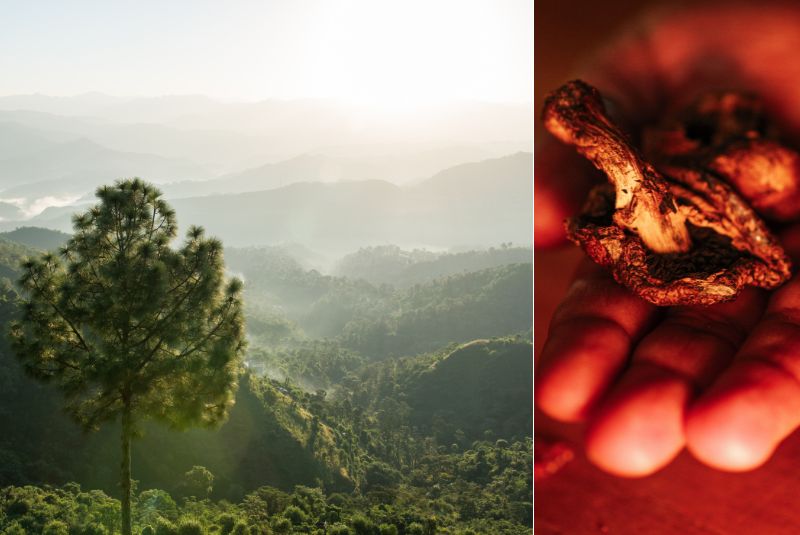
Naar celebrates the Himalayas through the mountain range’s ingredients
Set in the tiny village of Darwa in India’s Himachal Pradesh, Naar opens its doors to the public on 24th November. Meaning ‘fire’ in Kashmiri, Sadhu’s mother tongue, Naar refers not only to the wood-fired, grill-centric menu featuring “Himalayan-forward cuisine”, but more importantly to the flame burning inside the chef to build a sophisticated restaurant in a tiny Himalayan village in northern India, away from the comforts and conveniences of a big city.
“The future of Indian cuisine relies on the stories of all its regions being told. At Naar, I’m cooking the mountains,” explains Sadhu. His goal is to shine a light on the produce, people and foods that characterise India’s Himalayan belt, which spans six states – Ladakh, Himachal Pradesh, Uttarakhand, Sikkim, Kashmir and Arunachal Pradesh. “I don’t just want to highlight where an ingredient comes from, but also the stories and rituals associated with it,” he continues while driving along a path that cuts through the mountains to Amaya, a 15-key boutique hotel spread across 20 acres. Nestled in a corner of Amaya and perched atop a cliff that overlooks a valley of endless hills is Naar.
The journey to Naar
Sadhu, 36, hails from Kashmir, the troubled paradise state that he was forced to leave with his family in 1990, fleeing militancy and violence in the region. During his childhood, he viewed food through the lens of survival rather than celebration and has since brought this sense of respect and reverence to his cooking.
During his time at Mumbai’s celebrated restaurant Masque, Sadhu – an alumnus of the Culinary Institute of America with stints at Alinea, Noma and The French Laundry behind him – shot to fame for his ability to bring lesser-known Indian ingredients to the fore, marrying them with complex cooking techniques. The restaurant is now a regular on the Asia’s 50 Best Restaurants list, coming in at No.16 in 2023 as the highest-ranking establishment in India.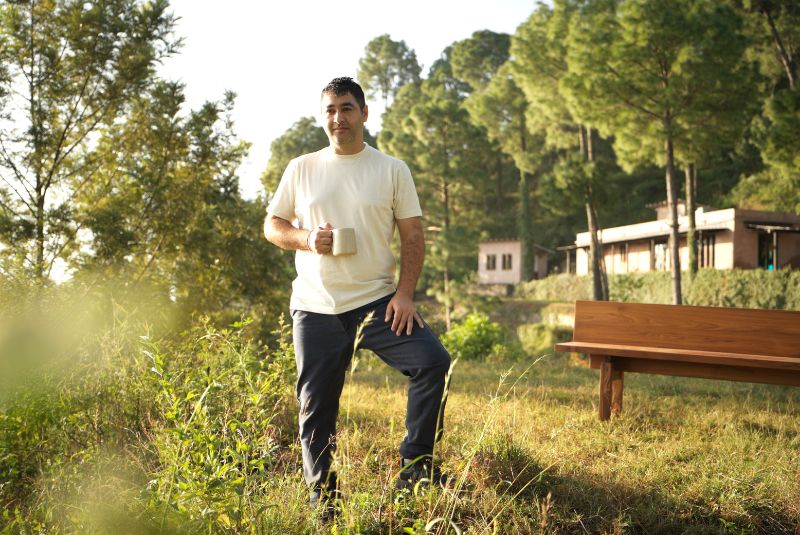
Chef Prateek Sadhu's cooking style is based on the use of little-known Indian ingredients
After jet-setting across the world for glamorous four-hand dinners, racking up prestigious awards and being featured on numerous buzzy lists, Sadhu sent ripples across India’s restaurant industry in March 2022 when he parted ways with Masque, where he had been executive chef since the venue’s inception in 2016. “I believe my heart and soul are in the mountains,” he says, gazing now at the view from Naar.
While attempts have been made at creating high-end dining options in the Himalayan region before, none have been helmed by a chef at the height of the culinary prowess and fame Sadhu currently enjoys. This is a crown he doesn’t wear lightly. “A lot is riding on this restaurant,” he says. “Not just in terms of financials, but also in terms of personal resources.” His wife and team – a multi-talented, friendly crew of 11, assembled from some of India’s finest kitchens – have all moved their lives to the mountains to help build this dream.
Building a vision
Naar looks and sounds like every chef’s wildest fantasy: a 20-seater, chef-driven experimental restaurant with views of the Himalayas, the world’s greatest mountain range. Here, Sadhu and his crew can breathe in crisp mountain air, stroll to the two-acre farm less than a kilometre away and forage wild herbs along the banks of bubbling brooks and gushing rivers nearby. It feels fantastic – but also, wildly ambitious.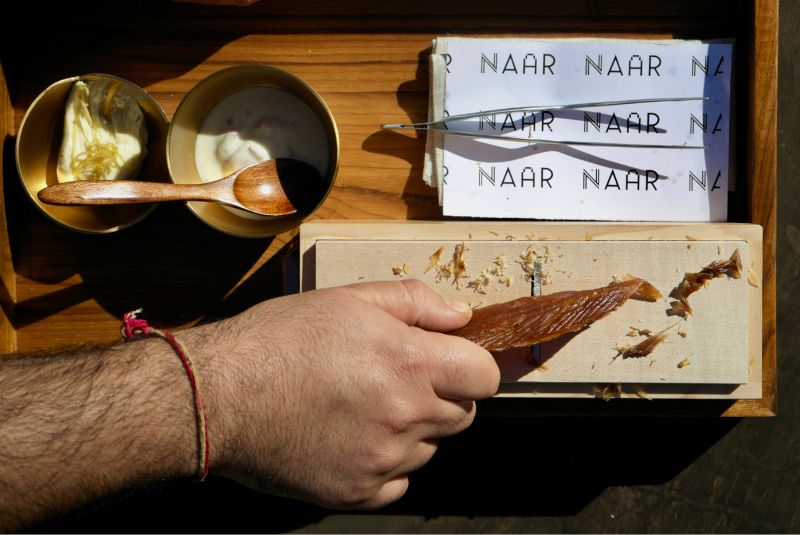
'Naar' means fire in Kashmiri
The closest airport – Chandigarh’s Shaheed Bhagat Singh International Airport – is a 90-minute drive away, so any large deliveries must first arrive to an office in the city before someone from the restaurant picks them up. The team, housed together in separate accommodations for men and women provided by the restaurant, lives 15 minutes away. The region’s restaurant watchers are waiting with bated breath; meanwhile, Sadhu is determined to succeed.
“I’ve spent so long travelling across the Himalayan belt and each time I visit, I’m made aware of how little I know,” he says. The restaurant’s food philosophy takes its cues from Himalayan culinary traditions as well as the fluidity of the seasons in the hills.
In a nod to the changing seasons and the bounty of unique ingredients they bring, Naar’s logo has six iterations that reference spring, summer, monsoon, autumn, pre-winter and winter. “During the spring, you’ll be able to look through the windows and gaze at fresh blossoms as well as see them on your plate,” says Sadhu. Wild herbs and flowers often show up as star ingredients across the cuisine of the Himalayas.
November is early winter in this region and the team is experimenting with the fruits of the season. “Wormwood and watercress – herbs I hadn’t heard of until I moved to Europe – grow in abundance right here, down by the river,” says Sadhu on a walk by a mountain stream. During dinner at Naar, watercress flowers make an appearance atop prickly pear sorbet shavings that sit in a pool of green chilli juice. It’s both wild and mouth-puckeringly delightful.
Biting into a new story
Guests at Naar can choose to experience the multi-course tasting menu paired with cocktails, wine or non-alcoholic drinks, expertly mixed and muddled by mixologist Samarth Varma. The dining experience begins in the salon, what Chef Sadhu describes as his ‘living room’, for cocktails and canapés. Fun 80s tunes waft from the speakers into the cosy space, done up in dark wood furniture and warm shades of earth brown and grey.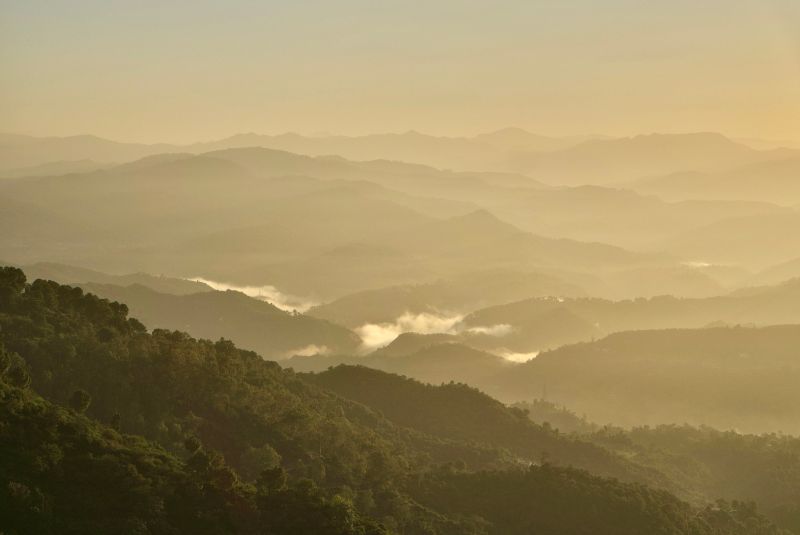
The incredible view of the Himalayan belt seen from the restaurant
Varma serves a range of libations that play with house-made liqueurs made from the likes of sea buckthorn (a Himalayan berry) and almonds. There are also well-balanced drinks such as the Picante, garnished with chillies pickled in-house and fresh winter lime, plucked from the tree right outside.
In the main dining room, creative iterations of the seasons featuring the best of the Himalayan belt are on display. Brined pork, showcasing the region’s fermentation techniques, is served with a range of condiments, such as finely diced Himachali apples, Sikkimese bamboo shoot pickles, apricot jam and a hemp seed chutney popular in Uttarakhand.
Non-vegetarians can look forward to courses such as ‘Project Trotto’, dedicated to showcasing the Himalayan trout in all its glory – a course of smoked fish bone broth and cured fish seasoned with trout that is salted, smoked and dried, just like bonito flakes. “You won’t see things like shellfish on my menu because it’s not endemic to the region,” explains the chef. A trio of shrooms – picked by the team the previous day – show up, all grilled, meaty and glorious.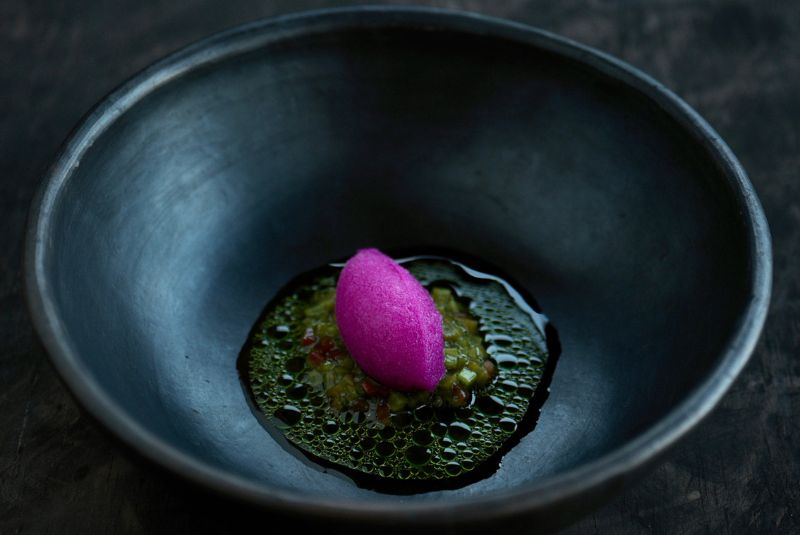
The restaurant opened in November 2023
The meal ends with a dessert of pine nut ice cream drizzled with pine oil and fermented pine syrup sitting on a bed of preserved pine. Soon after, it’s time for the cheese trolley – featuring cumin-flecked gouda and cheddar sourced from a nearby fromagerie – to make the rounds. The funky cheeses are paired with cognac and the stunning views of the valley below, now illuminated by bright stars. It’s a fitting end for a meal that showcases the best of the Himalayas.
Is Sadhu trying to redefine Indian cuisine at Naar? “This restaurant is a sum of my experiences. I’m trying to build a new language for what our cuisine can be,” comes the confident answer.
Reservations for Naar are now open via reservations@restaurantnaar.com. The restaurant opens for service on 24th November 2023.
Follow 50 Best on Instagram, Facebook, Twitter and YouTube for the latest news, features, videos and stories from the best chefs and bartenders across the world, and browse 50 Best Discovery for travel inspiration.
.jpg)
